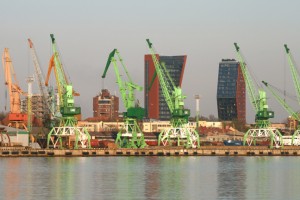
The expansion of Russian port capacity has already reduced traffic at Lithuania's Klaipėda port, one of the largest in the eastern Baltic Sea region. Photo by Nathan Greenhalgh.
VILNIUS — On a visit to the Kaliningrad exclave Russia’s deputy prime minister said his country plans to upgrade its freight capabilities in its own Baltic seaports to reduce reliance on the Baltic states for cargo.
Deputy Prime Minister Sergei Ivanov said that within two to three years the capacity of the Port of Ust-Luga, located near St. Petersburg, would be increased enabling Russian ships to stop using ports in Lithuania, Latvia and Estonia. The Russians have been developing the Ust-Luga port for several years to wean off the use of foreign ports in the Baltic Sea, spending 60 billion rubles on the port since 2005. One of Ust-Luga’s principal cargo will be oil pumped through the new BPS-2 pipeline, currently handled by Estonian ports.
“I have asked the transport department about cargo transshipment in Russian ports. I have been informed that 75 percent of transshipment of export-import cargo was carried out in foreign ports in 1998-1999 and only 25 percent in Russian ports. The current ratio is 13 percent to 87 percent. I think this is a very good dynamic, and we will fully remove our dependence on foreign ports in the foreseeable future. This is extremely important for the national economy and in regards to additional jobs,” Ivanov said in a press release published on the Russian prime minister’s website.
“Until recently, Russian seaports had no fuel oil transshipment terminals, so we had to export about 17 million metric tons of the commodity via Estonian ports,” Ivanov said. “There will be no need to continue our oil product exports and imports through Estonian ports.”
Competing expansions
The Russian announcement comes a week after the Free Port of Riga made public its plan to invest hundreds of millions of lats to upgrade its capacities.
The Latvian Ministry of Transportation acknowledged that the Russian long-term plans for Baltic ports.
“Russia is upgrading the port, we know it, we know it already for several years,” Andris Maldups, director of the ministry’s transportation policy department, told Baltic Reports. “There is a decrease in container cargo.It’s about 20 percent, but I think it’s quite normal because it’s a decrease of consumption due to the global crisis because this is import cargo to Russia. This has decreased in St. Petersburg and other ports.”
Maldups said the Baltic countries’ ports will find steady traffic with Asian customers regardless of what the Russians did with their ports.
“We believe there will be quite a lot of cargo for the Baltic states, such as niche cargo … it’s about containers, taking to/from Central Asia,” he said. “We’re working in cooperation with China to bring cargo into Northern Europe.”
An estimated 90 percent of Russian imports and exports are currently transported through the Baltic ports, aiding the economies of the three countries. The Russian’s move toward using domestic ports will hurt the three country’s economies by reducing port and railroad traffic.
Ivanov said that just from the development work done on Russia’s ports in 2008, the country was able to reduce reliance on foreign ports by 20 percent.
Lithuanian ports have not been spared. In the first half of this year, Klaipėda port handled 25 percent less goods from Russia compared to the same period in 2008. By the time all upgrades are completed, the capacity of the port will be several times higher than that of Klaipėda.
Ust-Luga port, situated in the Gulf of Finland, is primarily a coal and fertilizer terminal but by 2011 will carry more oil. The port was opened in 2001 in part to avoid dry cargo shipments through the Baltic states. The port’s 3,700-meter approach canal is deep and capable of accommodating ships with a capacity of 150,000 tons.
— Baltic Reports editor Nathan Greenhalgh contributed to this article.












